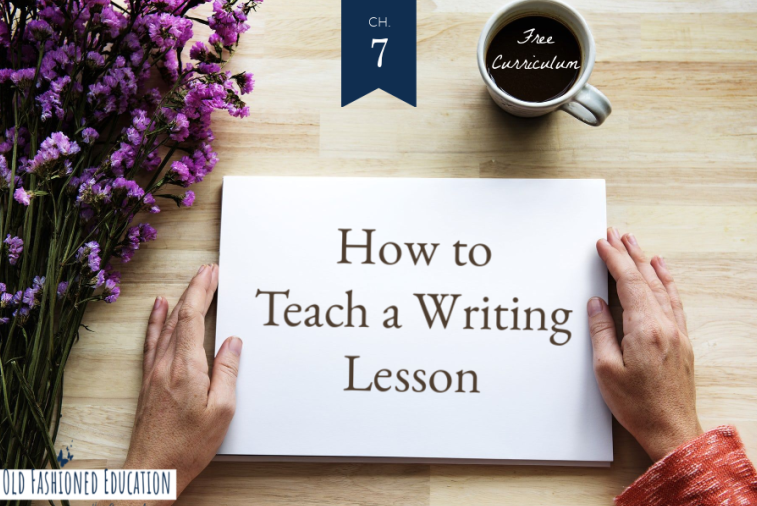|
In Chapter 7 of the Teaching Series, I will be sharing my Charlotte Mason-inspired method for teaching the writing lesson in 3 simple steps! A Few PreliminariesYou will need:
Tip! Keep the desk cleared off. Do not give the handwriting book or pencil until step 3 or after the lesson is taught at the chalkboard. Firstly, this 3-step method works well with our Enjoying Penmanship Series, however this method can be used with the handwriting book of your choice. Secondly, the objective for the writing lesson is to show your child how to form a letter, stroke-by-stroke, and give ample practice until he makes one that is very good. "Let the child accomplish something perfectly in every lesson - Thirdly, Charlotte Mason advised us to keep the writing lesson short - about 10 minutes. She emphasized quality over quantity making writing a joy and keeping the attention of the child. Now, let the lesson begin. Step 1: I Do (1-2 Minutes)At the chalkboard, start by showing your child how to form one letter (per lesson). Place a starting dot on the chalkboard and name each stroke as you make it. For letter A, you might say: Slanted line down, slanted line down, and straight line across. Repeat once to reinforce. Summary: "I Do" means your child will see you and hear you form the letter, stroke-by-stroke. it also means they will understand where the letter starts by seeing the "starting dot." Step 2: We Do (1-2 Minutes)Next, guide your child to practice the strokes of the letter in the air and on the chalkboard. Guide him or her to make the strokes in the air with the pointer finger while saying the strokes aloud with you (slanted line down, slanted line down, and across). Repeat 2 or 3 times. Now, place a starting dot on the chalkboard and let your child write their own letter A. Give lots of praise! Summary: "We Do" means your child is learning the strokes with you together. Step 3: You Do (5-8 Minutes)Finally, place the handwriting workbook and pencil on the desk for your child's seatwork. Let him or her practice writing the letter independently and raise a hand when finished. Give praise and draw a star by each letter that is well done. Give a second try for the ones that need improved. * Summary: "You Do" means the child practices independently on paper for about 5 to 10 minutes. So, it's that easy! Just teach one letter per lesson, stroke-by-stroke, following the pattern of I Do, We Do, You Do and your child will progressively become more independent in forming letters. Handwriting Workbook Suggestions
*Keep verbal guidance to just one improvement at a time such as "start at the dot" or "remember the first stroke is this slanted line down" or "try to bump the bottom line, but don't go below." Final Thoughts + Hands-On IdeasNotice that the 3-steps are: I, We, You. They are progressively moving your child toward writing independently. Dig-in and really teach the strokes of each letter visually and orally. You can do it. Plus, by applying our Charlotte Mason-inspired method of short lessons, quality work (over quantity) and lots of praise (limit suggestions for change), I hope you can see how you and your child will be enjoying penmanship! That's why we gave our series that name - it is not supposed to be mundane or burdensome, but truly enjoyable. Also, if your child responds to a tactile approach (hands-on), do use letter playdough mats (included in our Prep-level Teacher Guides) to form the strokes with playdough or a tub of sand or rice to form the letter strokes, but don't skip writing the letter on paper. Questions AnsweredHow many letters should my child form during seatwork?
Remember, the goal is quality, not quantity. For prep-level students, let them practice writing the letter of the lesson 5 to 10 times, or one page, keeping to 10 minutes.
How many writing lessons should i teach per week?
We recommend two writing lessons per week, but a student should practice more often.
What is copywork?
The writing lesson digs-in and teaches how to form each letter stroke-by-stroke, while copywork gives the child practice with copying whole language selections such as scripture, poetry, or prose. Our grade-level Enjoying Penmanship Series includes copywork.
Tip! Copywork does not replace the writing lesson. What is dictation?
Dictation is when you say a letter or word, and the child writes it down from memory. We include a place for dictation in our Enjoying Penmanship Series.
Do you have a favorite penmanship book?
0 Comments
Your comment will be posted after it is approved.
Leave a Reply. |
AuthorRenee Metzler holds a degree in Secondary Ed, English from Bloomsburg University of PA. She is a homeschool mom of 4 children and is loves to share her joy of lesson planning and curriculum. CategoriesAll 101 Top Picks! Activity Box Charlotte Mason Find/List A Co-op Homekeep Homeschool Level 0 (PreK K) Level 0 (PreK-K) Level 1 (Grades 1 3) Level 1 (Grades 1-3) Level 1 (Grades 1 To 3) Level 2 (Grades 4 To 6) Living Books Member Forum Motherhood Parent's Review Planning Science & Nature Teaching Series Archives
July 2024
|
Search by typing & pressing enter



 RSS Feed
RSS Feed
